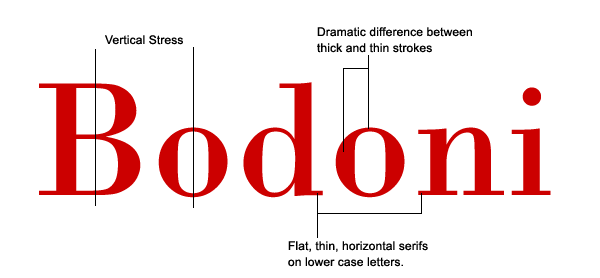Although people use the terms font and typeface interchangeably, typeface is about the design. Typeface refers to a particular style of type making an image have a uniformed appearance.
Characteristics:
Stroke- Can move vertically, horizontally, diagonally, or in a curved direction. In hand lettering the width of the stroke can vary as the angle and direction of the nib changes with the movement of the pen.
Contrast- The transitions between the thick and thin areas of a stroke is the contrast. Low- contrast has little to no variation between the thick and thin portions of the stroke. Readers can view high- contrast typefaces easily for they are more pronounced.
Stress- The location or angle of a transition from thick to thin or vice versa. In vertical stress fonts, the transition occurs at the top and bottom of vertical axis. In angled, the transition takes place off-axis.
Weight (regular, boldface, light)- Boldface increases width and the visual weight of the regular roman letterform. Light typefaces does the opposite, with small stroke widths.
Posture (Roman, oblique, italic)- The term Roman with and uppercase R refers to the inspiration of certain typefaces and to categories of typefaces. The lowercase r, however, refers to upright typefaces. Oblique and Italic usually slant to the right. Oblique will use roman counterparts while Italic typefaces have features that emulate handwritten forms.
Proportions and letterforms Parts- The basic characteristics of typeface: baseline, capline, mean line, x-height, counter, ascender, descender, memospaced, and etc.


San serif vs. serif- Serifs are decorative accents added to the end of a stroke. The word Sans in French means "without", thus san serif typefaces are those without serifs.
Decorative typefaces- Connote a sense of mood, emotion, or attitude. They have personality, which is great for attracting attention, but little for enhancing the readability of the text.
Script fonts- Attempt to emulate the cursive style of handwriting or the artistic appearance of calligraphy. Scripts are slanted, and a stroke connects adjoining letters and preserves linear flow.
Symbols and special characters- Many common symbols are included in the Universal Character Set. Many special characters can be added to a document by combining a modifier key with a character code. The design of the inserted character with match the style of the currently active typeface if using this method.







No comments:
Post a Comment